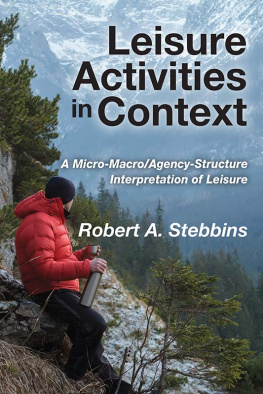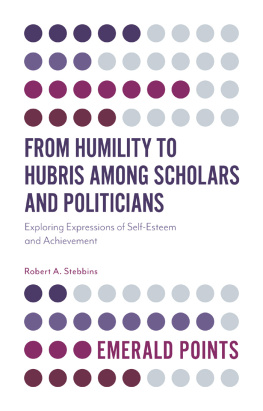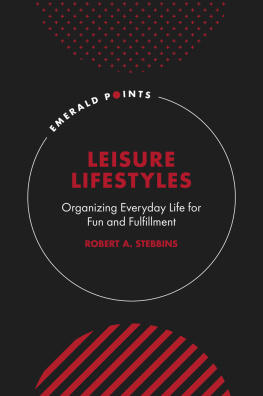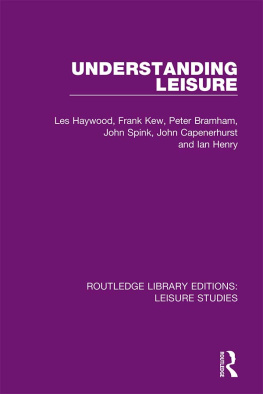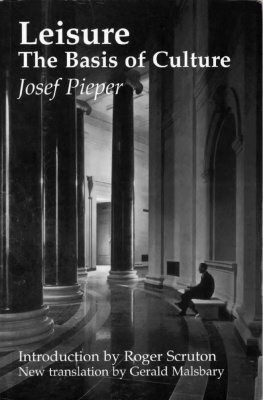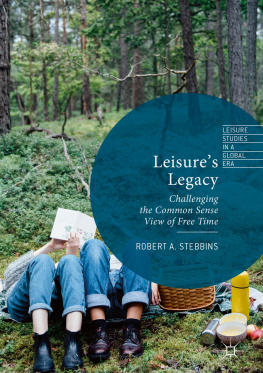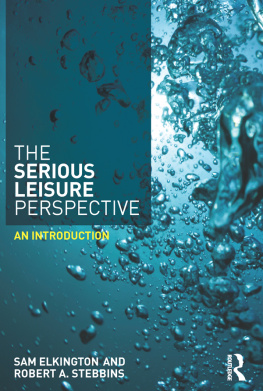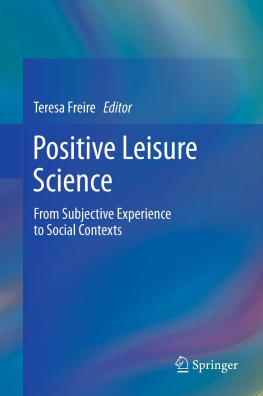Leisure
Activities
in Context
Leisure
Activities
in Context
A Micro-Macro/Agency-Structure
Interpretation of Leisure
Robert A. Stebbins

Transaction Publishers
New Brunswick (U.S.A.) and London (U.K.)
Copyright 2017 by Transaction Publishers, New Brunswick, New Jersey.
All rights reserved under International and Pan-American Copyright Conventions. No part of this book may be reproduced or transmitted in any form or by any means, electronic or mechanical, including photocopy, recording, or any information storage and retrieval system, without prior permission in writing from the publisher. All inquiries should be addressed to Transaction Publishers, 10 Corporate Place South, Suite 102, Piscataway, New Jersey 08854. www.transactionpub.com.
This book is printed on acid-free paper that meets the American National Standard for Permanence of Paper for Printed Library Materials.
Library of Congress Catalog Number: 2016026180
ISBN: 978-1-4128-6412-1
eBook: 978-1-4128-6376-6
Printed in the United States of America
Library of Congress Cataloging-in-Publication Data
Names: Stebbins, Robert A., 1938- author.
Title: Leisure activities in context : a micro-macro/agency-structure interpretation of leisure / Robert A. Stebbins.
Description: New Brunswick, New Jersey : Transaction Publishers, 2016. | Includes bibliographical references and index.
Identifiers: LCCN 2016026180 (print) | LCCN 2016046501 (ebook) | ISBN 9781412864121 (hardcover : acid-free paper) | ISBN 9781412863766 (ebook) | ISBN 9781412863766
Subjects: LCSH: Leisure--Sociological aspects.
Classification: LCC GV14.45 .S833 2016 (print) | LCC GV14.45 (ebook) | DDC 306.4/812--dc23
LC record available at https://lccn.loc.gov/2016026180
Contents
To Chris Rojek
Chris Rojek and I have been seen by many of our colleagues in leisure studies as representing, respectively, the macro/structural and micro/agency poles of theory in that field. In fact, both of us have occasionally strayed into the others presumed theoretic territory, as when Chris discusses intentionality and I write about the organizational and historical bases of various leisure activities. As for me, it was in reading over the years a number his books and articles that I began to consistently see leisure in macro structural terms as well as continuing to see it at the micro and meso levels, in harmony with my initial formation in symbolic interactionism. This book is, among things, an attempt to bring us together intellectually, which I believe Chris will appreciate, even if he, guided by the same goal, would probably execute this link differently.
My editors at Transaction have always been first-rate. Caroline Russomanno has, with this book, certainly kept up that tradition. Many thanks!
I have been arguing in recent yearssince Stebbins (2009a) to be precisethat serious, casual, and project-based leisure, while they can be partly explained as activities that offer their participants either enjoyable or fulfilling experiences, can also be substantially explained by the social, historical, cultural, temporal, and geographical contexts in which they are pursued. This is, of course, a leisure studies version of the time worn, social science concern about the explanatory dominance of micro vis--vis macro level theory and related research, known in theoretical circles as the micromacro/agency-structure debate. The word contextmy preferred summary term for the micromacro/agency-structure levels of phenomenaincludes a variety of collective formations, many of which unfortunately are commonly given short shrift in the diverse abstract arguments about context. These formations are the social worlds, formal organizations, social institutions, spatial arrangements, social movements, and global postmodern tribes that characterize modern social life. By contrast, certain other meso and macro level phenomena have been much more fully examined. In leisure studies they include statements about leisure trends (e.g., Rojek and Blackshaw), historical changes in leisure (e.g., Spracklen, Cross, and Gelber), cultural practices as leisure (e.g., Chick, Rojek, and Roberts), and some of the social problems generated from time to time by the search for leisure (e.g., inequality of leisure opportunity, deviant leisure, unhealthy leisure practices, and annoying leisure activities).
Intrapersonal, interpersonal, and structural leisure constraints fit in this contextual analysis in distinctive ways and psychological conflict. Nevertheless, this distinction can be fuzzy, especially when constraint and context refer to the same condition or situation. And speaking of conceptual fuzziness here we also find leisure facilitators, where it can happen that one persons facilitator is anothers constraint.
In other words, my intention is to present the big picture of leisure, with big picture being defined in Websters Collegiate Dictionary (11th ed.) as the entire perspective on a situation or issue. Big pictures do not, at least should not, ignore the component elements of which they are comprised, which in the present volume, means I must also devote sufficient attention to the micro/agency part of the portrait to show how it fits there. Nonetheless, this book is dominantly about the meso- and macro-structural parts of the big picture that frame leisure activity and experience. These two parts are thinly and unevenly discussed in the leisure studies literature.
By and large this book reports no new (heretofore unpublished) research data. Rather, it is primarily a theoretic undertaking, wherein I aim to show how both leisure as free-time activity and a sample of the existing leisure studies literature can be fruitfully understood in a new light, namely, that of context. Using this big-picture approach, I want to explain leisure in a broad, holistic manner, something never attempted on this scale. That is, there have been any number of micro, meso, and macro analyses of leisure, but never to my knowledge has anyone tried to show how these three levels of context fit together in that domain. To this end, some special concepts appear in this new picture: context, embeddedness (Jonathan Turners concept), constraints and facilitators, and incorporation and linking (for the latter two, see especially Chapters 3 and 10). My hope is that every reader of this book will come to see each instance of leisure behavior or activity in the big contextual picture painted here rather than viewing it only on one level (e.g., micro context).
In all this, I make no claim to solving the micromacro question. Yet the following pages do show that the past 40 some years of research and theory on leisure have shed considerable light on its context at all levels and on the ways that participants are embedded within them. This, however, constitutes a micro-to-macro analysis of only one part of society. However, perhaps this is the road to travel; to examine in much greater detail one segment of a society rather than attempting to examine all its segments at once. The latter approach seems to have become in the present a formidable stumbling block for such thinking. In short, the approach set out in this book shows how a rich micromacro/agency-structure analysis can be carried out using the leisure studies literature as a model (discussion continued in Chapter 10).
A set of basic concepts will guide this examination of the context of leisure. They are introduced in Chapter1: leisure, leisure as activity, self-efficacy and personal agency, agency

